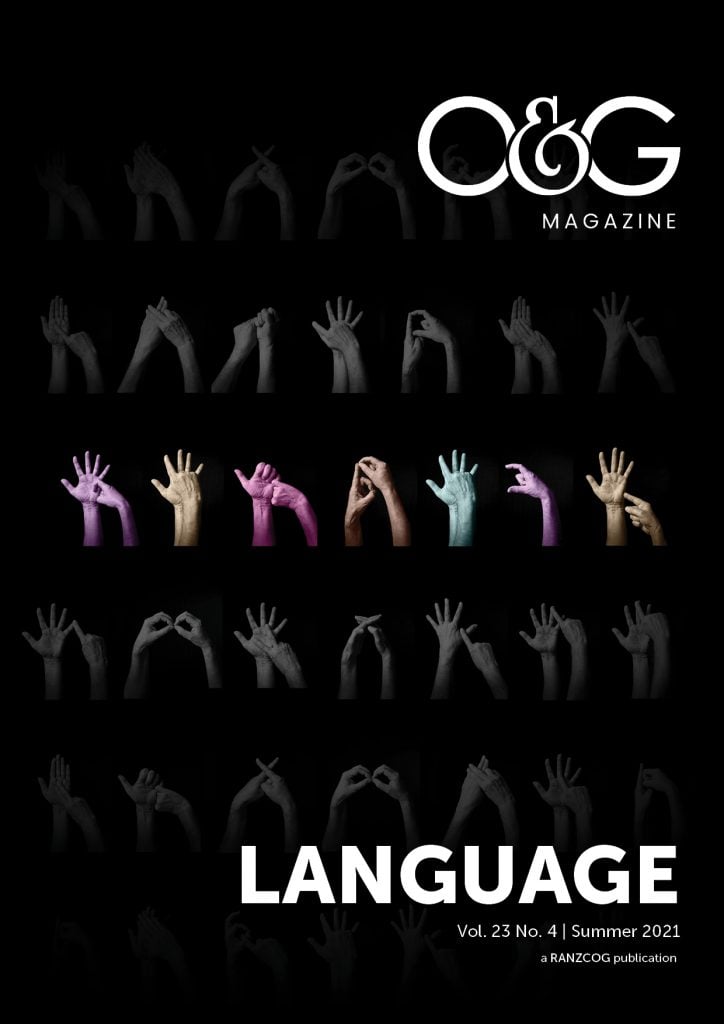If we cast back to university, much time was spent carefully learning an entirely new vocabulary. As a country public school kid, Latin was certainly not part of my high school curriculum. Yet with time, painful repetition and effort, this new medical language of anatomy, physiology, pharmacology and histopathology became gradually familiar. At some point along the journey, we become unconsciously competent in this language as we write our notes, handover patients and refer to colleagues. This shared language that emerges amongst clinicians draws from medical terminology – ‘those technical, specific, standardised and precise words, terms and phrases that are used in medicine’1 – but medical language is more than just scientific words. It is the application of these technical terms to construct a shared meaning with colleagues using phrases, jargon, accronyms and abbreviations, and expressions. This is perhaps most obvious in junior doctor training, when rotations between specialties demonstrate that the same abbreviations can have completely different meanings. An entirely different set of alarm bells start to ring internally when we are told about the hypertensive patient compared with the hypotensive one, and of course, this is informed by the broader patient context for the patient with preeclampsia compared with the one with a postpartum haemorrhage.
We have all become proficient in the specific syntax of this language and switch for the most part seamlessly. We speak differently for efficient handover of a full ward of patients or to explain complex health choices in plain language with our patients. However, there may also be times when this medical language starts to reflect and influence our stigmas, biases and depersonalisation, whether consciously or unconsciously. As Dr Bethany Boulton writes, there is an important, if subtle, difference between the ‘miscarriage in six’ and the ‘patient having a miscarriage in six.’2 Unfortunately, the populations objectified and stereotyped in common medical parlance may already be at increased risk of poorer health outcomes due to social disadvantages. Certain labels are weighted heavily with accompanying assumptions, like the ‘difficult patient,’ which may in fact better reflect the troubled clinician.3 The way we speak to, about, and with patients and priority populations influences our understanding of the factors that drive vulnerability and risk, and therefore how we might better engage with addressing these inequities.
The COVID-19 pandemic has seen some words become overused to the point of losing meaning – the misuse of unprecedented is a personal bug bear. As we dial in to daily press conferences, we hear our political leaders and celebrity Chief Health Officers reflecting on the vulnerability of specific patient groups. The oversuse of the word vulnerable tends to misplace and dispell more accurate recognition of the various social inequities that underlie this supposed vulnerability.4 Certainly, some groups can be considered vulnerable because of physiological differences that increase risk, such as for pregnant women who are at higher risk of complications from COVID-19 compared with non-pregnant women of the same age.5 But within this group, the risk is not equitably experienced if you consider the pregnant patient who is a front-line essential worker, in a casualised industry without access to sick leave, who is financially dependent on continuing to work in settings where they may be exposed to COVID-19, compared with the pregnant patient who is supported by their employer to work from home.
Reducing entire ethnic groups to their vulnerabilities is a new kind of scientific racism,8 and the overfocus on those experiencing these disparities renders invisible those groups responsible for, and who may benefit from, these inequities.9 As we repeatedly witness differential outcomes from COVID-19 for First Nations and other ‘racially minoritised’10 groups the world over,11 12 failure to unpick the underlying causes of this ‘vulnerability’ is a missed opportunity to fundamentally address these systemic factors and Build Back Fairer.13 In Australia last year we also saw firsthand the power of partnership, codesign, and Community Control,14 terms which carry an entirely different set of empowering assumptions. The potentially increased risk of poorer outcomes from COVID-19 for Aboriginal and Torres Strait Islander peoples was recognised early by Community Leaders, based on a nuanced understanding of the social determinants of health and the ways in which social disadvantage contributes to a higher burden of chronic disease, barriers to accessing healthcare, and increased risk factors for transmission, like large household size and poor housing infrastructure.15 16 Ensuring Community Control and cultural governance are centred in pandemic response efforts leverages the strengths of closeness and connectedness within Communities and recognises that vaccines are but one vital tool that must be accompanied by broader improvements to health service access.
Despite the tangible implications for patient safety, this focus on language, cultural safety and inclusion may seem disconnected from our daily clinical work. There is sometimes an unspoken implication that preferences the successful proceduralist over the succesful communicator. The experiences that matter to our patients, like feeling they have an opportunity to express their concerns,18 may not always align with the enforced clinical priorities of our challenging workloads. It can also be confronting to apply labels like sexism, racism, or homophobia to our professional experiences and clinical institutions. For me, the power of an intersectional approach is in recognising that we can each have multiple axes of identity that simultaneously and cumulatively influence our perspectives and experiences.19 20 This is less about aportioning blame or comparing privileged identities, but rather to create opportunities for reflexivity and to learn from marginalised voices while recognising the burden repeatedly imposed on the oppressed to serve as educators.21
We know that racism diminishes all of us, and it is increasingly recognised as an independent social determinant of health.22 23 We must listen when our colleagues tell us that internalised, interpersonal and institutionalised racism contribute to tangible negative health impacts.24 Fostering inclusion and diversity within our health services is vital to ensuring we provide culturally safe and accessible care for our patients, but also underpins how we engage with each other as colleagues. I want to be part of a health system where we can all safely be our whole selves at work.
Ultimately, many of the practices that we would incorporate to provide gender-affirming and culturally safe care align with the broader principles of patient-centred care. Having expended so much effort in developing our skills in the science of medicine, it seems a shame to undermine this by failing at the art of medicine through ineffective communication. It costs me virtually nothing to approach patients free of assumptions, whether about their gender, sexuality, cultural identity or healthcare preferences. Yet subtle changes in language and communication can carry great significance for patient experiences and influence their future relationship with health services.25 Choosing our words wisely is just the first step in fostering inclusion and is an opportunity for each of us to influence cultural and system change. Like any other part of our practice, we may have moments of failure and error, especially where something is new. As with any clinical mistake, a sincere apology and a commitment to improve is surely the least we owe our patients as part of our collective commitment for empathetic care. We should similarly persevere and remind ourselves constantly to refocus on patient-centred care that is tailored to each unique individual, their partners, carers, family, and community.
Our feature articles represent the views of our authors and do not necessarily represent the views of the Royal Australian and New Zealand College of Obstetricians and Gynaecologists (RANZCOG), who publish O&G Magazine. While we make every effort to ensure that the information we share is accurate, we welcome any comments, suggestions or correction of errors in our comments section below, or by emailing the editor at [email protected].
References
- Hull M. Medical language proficiency: A discussion of interprofessional language competencies and potential for patient risk. International Journal of Nursing Studies. 2016;54:158-72.
- Boulton, B. 2021. ‘Words can Hurt in the ED’. Allergy and Respiratory Republic. Available from: puffnstuff.com.au/words-can-hurt-in-the-ed/24915.
- Crutcher JE, Bass MJ. The difficult patient and the troubled physician. J Fam Pract. 1980;11(6):933-8.
- Munari SC, Wilson AN, Blow NJ, Homer CSE, Ward JE. Rethinking the use of ‘vulnerable’. Australian and New Zealand Journal of Public Health. 2021;April 5.
- RANZCOG. 2021. COVID-19 Vaccination in Pregnant and Breastfeeding Women and those planning pregnanc. Available from: ranzcog.edu.au/statements-guidelines/covid-19-statement/information-for-pregnant-women.
- Katz AS, Hardy B-J, Firestone M, et al. Vagueness, power and public health: Use of ‘vulnerable ‘in public health literature. Critical Public Health. 2020;30(5):601-11.
- Khenti A, Bobbili SJ, Sapag JC. Evaluation of a Pilot Intervention to Reduce Mental Health and Addiction Stigma in Primary Care Settings. Journal of Community Health. 2019;44(6):1204-13.
- Katz AS, Hardy B-J, Firestone M, et al. Vagueness, power and public health: Use of ‘vulnerable ‘in public health literature. Critical Public Health. 2020;30(5):601-11.
- Milner A, Jumbe S. Using the right words to address racial disparities in COVID-19. Lancet Public Health. 2020;5(8):e419.
- Milner A, Jumbe S. Using the right words to address racial disparities in COVID-19. Lancet Public Health. 2020;5(8):e419.
- Steyn N, Binny RN, Hannah K, et al. Māori and Pacific People in New Zealand have higher risk of hospitalisation for COVID-19. medRxiv. 2021:2020.12. 25.20248427.
- Alaa AM, Qian Z, Rashbass J, Pinto KG, et al. Ethnicity and outcomes of COVID-19 patients in England. NHS Digital. 2020.
- Marmot M, Allen J, Goldblatt P, et al. Build back fairer: the COVID-19 Marmot review. The pandemic, socioeconomic and health inequalities in England. 2020. Available from: www.instituteofhealthequity.org/resources-reports/build-back-fairer-the-covid-19-marmot-review.
- Wilson-Matenga G, Campbell M, Katterl R, et al. Partnership, trust and respect: NSW’s response to COVID-19 among Aboriginal people. Australian and New Zealand Journal of Public Health. 2021;45(4):315-7.
- Munari SC, Wilson AN, Blow NJ, Homer CSE, Ward JE. Rethinking the use of ‘vulnerable’. Australian and New Zealand Journal of Public Health. 2021;April 5.
- Crooks K, Casey D, Ward JS. First Nations people leading the way in COVID-19 pandemic planning, response and management. Med J Aust. 2020;213(4):151-2.
- McInerney, M. 2021. ‘COVID responses must be culturally safe to be effective say health leaders.’ Croakey Health Media. Available from: www.croakey.org/covid-responses-must-be-culturally-safe-to-be-effective-say-health-leaders.
- Street RL, Makoul G, Arora NK, Epstein RM. How does communication heal? Pathways linking clinician–patient communication to health outcomes. Patient Education and Counseling. 2009;74(3):295-301.
- Collins PH. Black feminist thought in the matrix of domination. Black feminist thought: Knowledge, consciousness, and the politics of empowerment. 1990;138(1990):221-38.
- Crenshaw K. Demarginalizing the intersection of race and sex: A black feminist critique of antidiscrimination doctrine, feminist theory and antiracist politics. u Chi Legal f. 1989:139.
- Lorde A. Age, race, class, and sex: Women redefining difference: Routledge; 2021.
- Paradies Y, Ben J, Denson N, et al. Racism as a determinant of health: a systematic review and meta-analysis. PloS one. 2015;10(9):e0138511.
- Devakumar D, Selvarajah S, Shannon G, et al. Racism, the public health crisis we can no longer ignore. Lancet. 2020;395(10242):e112-e3.
- Australian Indigenous Doctors’ Association. Policy Statement: Racism in Australia’s health system Canberra, Australia: AIDA; 2015. Available from: www.aida.org.au/wp-content/uploads/2017/08/Racism-in-Australias-health-system-AIDA-policy-statement_v1.pdf.
- Moseson H, Zazanis N, Goldberg E, Fix L, Durden M, Stoeffler A, et al. The imperative for transgender and gender nonbinary inclusion: beyond women’s health. Obstetrics and Gynecology. 2020;135(5):1059.






Leave a Reply